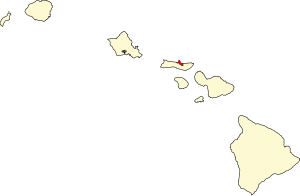
Father Damien or Saint Damien of Molokai or Saint Damien De Veuster, born Jozef De Veuster, was a Roman Catholic priest from Belgium and member of the Congregation of the Sacred Hearts of Jesus and Mary, a missionary religious institute. He was recognized for his ministry, which he led from 1873 until his death in 1889, in the Kingdom of Hawaiʻi to people with leprosy, who lived in government-mandated medical quarantine in a settlement on the Kalaupapa Peninsula of Molokaʻi.
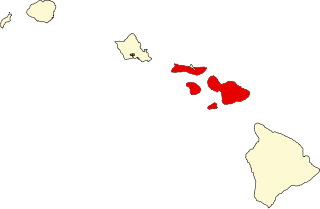
Maui County, officially the County of Maui, is a county in the U.S. state of Hawaii. It consists of the islands of Maui, Lānaʻi, Molokaʻi, Kahoʻolawe, and Molokini. The latter two are uninhabited. As of the 2020 census, the population was 164,754. The county seat is Wailuku.

Molokai is the fifth most populated of the eight major islands that make up the Hawaiian Islands archipelago in the middle of the Pacific Ocean. It is 38 by 10 miles at its greatest length and width with a usable land area of 260 sq mi (673.40 km2), making it the fifth-largest in size of the main Hawaiian Islands and the 27th largest island in the United States. It lies southeast of Oʻahu across the 25 mi (40 km) wide Kaʻiwi Channel and north of Lānaʻi, separated from it by the Kalohi Channel.

Kalaupapa Airport is a regional public use airport of the state of Hawaii, located on the northern peninsula of the island of Molokaʻi, two nautical miles north of Kalaupapa Settlement, in Kalawao County. Most flights to Kalaupapa originate from Molokai Airport or from airports on the other Hawaiian islands by unscheduled air taxis and general aviation. It is also used as a cargo facility carrying goods for Kalaupapa, which has no road access from the rest of Molokai.

Marianne Cope, OSF, was a German-born American religious sister who was a member of the Sisters of St. Francis of Syracuse, New York, and founding leader of its St. Joseph's Hospital in the city, among the first of 50 general hospitals in the country. Known also for her charitable works, in 1883 she relocated with six other sisters to Hawaiʻi to care for persons suffering leprosy on the island of Molokaʻi and aid in developing the medical infrastructure in Hawaiʻi. Despite direct contact with the patients over many years, Cope did not contract the disease.

Kalihi is a neighborhood of Honolulu on the island of Oʻahu in Hawaiʻi, United States. Split by Likelike Highway, it is flanked by Liliha, Chinatown, and Downtown Honolulu to the east and Mapunapuna, Moanalua, and Salt Lake to the west.
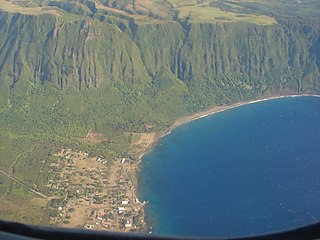
Kalaupapa is a small unincorporated community and Hawaiian home land on the island of Molokaʻi, within Kalawao County in the U.S. state of Hawaii. In 1866, during the reign of Kamehameha V, the Hawaii legislature passed a law that resulted in the designation of Molokaʻi as the site for a leper colony, where patients who were seriously affected by leprosy could be quarantined, to prevent them from infecting others. At the time, the disease was little understood: it was believed to be highly contagious and was incurable until the advent of antibiotics. The communities where people with leprosy lived were under the administration of the Board of Health, which appointed superintendents on the island.
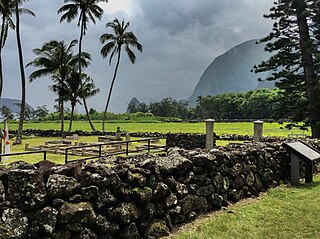
Kalaupapa National Historical Park is a United States National Historical Park located in Kalaupapa, Hawaiʻi, on the island of Molokaʻi. Coterminous with the boundaries of Kalawao County and primarily on Kalaupapa peninsula, it was established by Congress in 1980 to expand upon the earlier National Historic Landmark site of the Kalaupapa Leper Settlement. It is administered by the National Park Service. Its goal is to preserve the cultural and physical settings of the two leper colonies on the island of Molokaʻi, which operated from 1866 to 1969 and had a total of 8500 residents over the decades.

Kalawao is a location on the eastern side of the Kalaupapa Peninsula of the island of Molokai, in Hawaii, which was the site of Hawaii's leper colony between 1866 and the early 20th century. Thousands of people in total came to the island to live in quarantine. It was one of two such settlements on Molokai, the other being Kalaupapa. Administratively Kalawao is part of Kalawao County. The placename means "mountain-side wild woods" in Hawaiian.
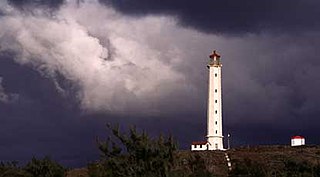
Molokai Light, also known as U.S. Coast Guard Molokai Light, is a lighthouse in Kalawao County, Hawaii, on the island of Molokai. It was built in 1909 and was listed on the National Register of Historic Places in 1982.
Leprosy stigma is a type of social stigma, a strong negative feeling towards a person with leprosy relating to their moral status in society. It is also referred to as leprosy-related stigma, leprostigma, and stigma of leprosy. Since ancient times, leprosy instilled the practice of fear and avoidance in many societies because of the associated physical disfigurement and lack of understanding behind its cause. Because of the historical trauma the word leprosy invokes, the disease is now referred to as Hansen's disease, named after Gerhard Armauer Hansen who discovered Mycobacterium leprae, the bacterial agent that causes Hansen's disease. Those who have suffered from Hansen's disease describe the impact of social stigma as far worse than the physical manifestations despite it being only mildly contagious and pharmacologically curable. This sentiment is echoed by Weis and Ramakrishna, who noted that "the impact of the meaning of the disease may be a greater source of suffering than symptoms of the disease".
The Hawaii State Department of Health (DOH) is a state agency of Hawaiʻi, with its headquarters in Honolulu CDP, Honolulu County, on the island of Oʻahu.
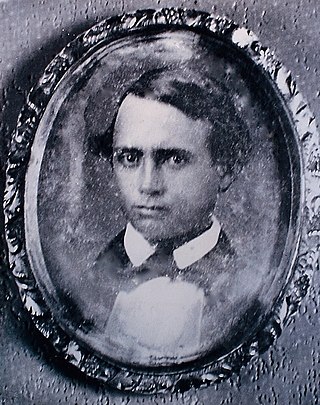
William Keolaloa Kahānui Sumner, Jr. was a high chief of the Kingdom of Hawaii through his mother's family; his father was an English captain from Northampton. Sumner married a Tahitian princess. Aided by royal family connections, he became a major landowner and politician in Hawaii.

Loretta Jean Fuddy was an American health official and social worker from the U.S. state of Hawaii. Fuddy served simultaneously as the Director of the Hawaii Department of Health and the Mayor of Kalawao County from 2011 until her death. Under Hawaii state law, the Hawaii Department of Health administers Kalawao County, and the Director of the Hawaii Department of Health, who is appointed by the governor, simultaneously serves as the Mayor of Kalawao County while in office.
The Mayor of Kalawao County is the chief executive officer of Kalawao County in the U.S. state of Hawaii. Kalawao County, which lacks a local government, is administered by the Hawaii Department of Health. Under Hawaii state law, the Director of the Hawaii Department of Health, who is appointed by the Governor of Hawaii, simultaneously serves as the Mayor of Kalawao County while in office. The Mayor of Kalawao County holds executive powers similar to other elected Hawaiian mayors, including the responsibilities of health, public safety, and law and order. The Mayor appoints a county sheriff selected from Kalawao County residents. The Mayor visits Kalawao several times a year to meet with local residents. Kalawao County, which is located on the Kalaupapa Peninsula on the north coast of Moloka'i, consists of three villages - Kalaupapa, Kalawao, and Waikolu.
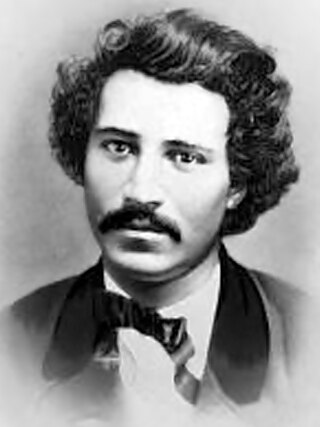
William Phileppus Ragsdale was a Hawaiian lawyer, newspaper editor, and translator. He was a popular figure known for being luna or superintendent of the Kalaupapa Leprosy Settlement. Elements of his life story influenced Mark Twain's 1889 novel A Connecticut Yankee in King Arthur's Court.

Ambrose Kanoealiʻi or Ambrose Kanewaliʻi Hutchison was a long-time Native Hawaiian resident of the Kalaupapa Leprosy Settlement on the island of Molokaʻi who resided there for fifty-three years from 1879 to his death in 1932. During his residence, he assumed a prominent leadership role in the patient community and served as luna or resident superintendent of Kalaupapa from 1884 to 1897.

Kauhakō Crater is a volcanic crater located in Kalawao County, Hawaii, United States. The crater was formed between 230,000 and 300,000 years ago, as the result of the eruption of volcano Pu'u' 'Uao. It is located in the center of the Kalaupapa Peninsula on the island of Molokaʻi, and has a diameter of 500 metres (1,600 ft) by 650 metres (2,130 ft). Lake Kauhakō, located at the bottom of the crater, has the world's greatest depth-to-surface area ratio of a lake and is the tenth deepest lake in the United States. In 2011, the lake underwent an overturning event, causing hydrogen sulfide to float to the surface of the lake and lifeforms, including shrimp and plankton, to disappear.

